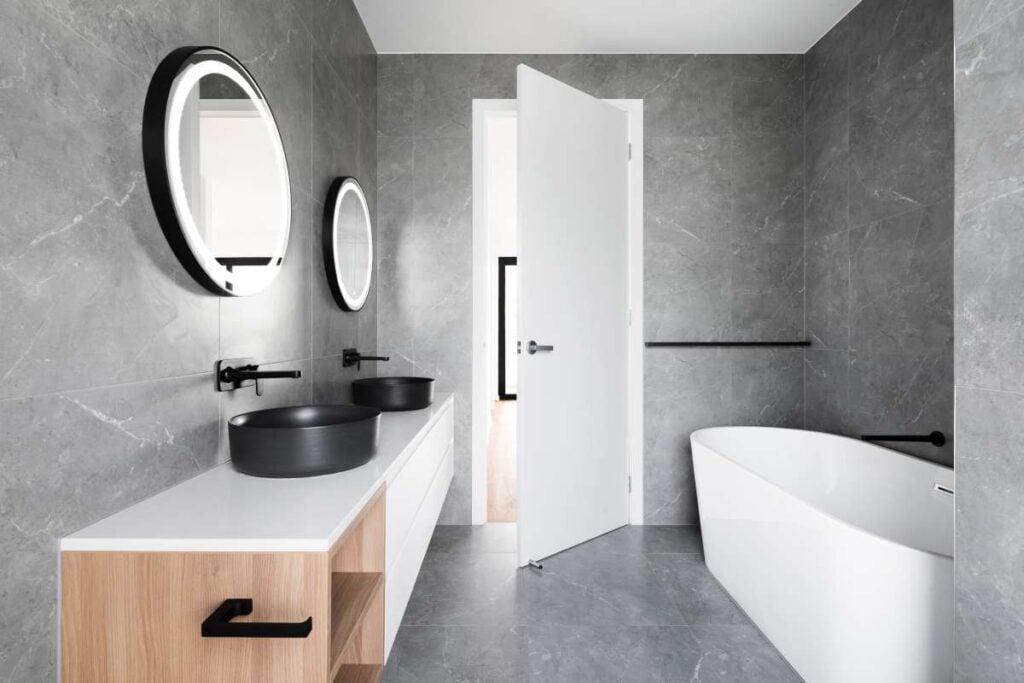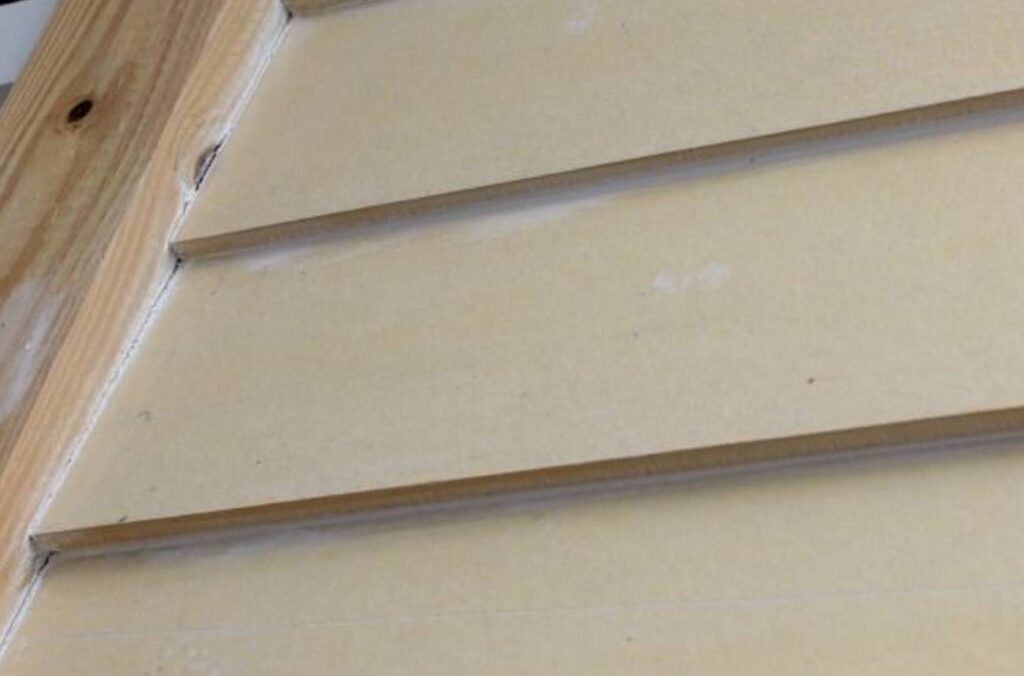Weatherboard cladding is a popular choice for cladding a home. Its timeless appeal, durability, and adaptability make it an excellent option for various house styles.
Weatherboards have been widely used in Australia since the first European settlers built structures, and they remain a key feature in everything from coastal shacks to suburban homes.
Let’s get straight to the point.
Weatherboard cladding is a versatile and durable choice for home exteriors, valued for its aesthetic flexibility, low maintenance, and easy installation. Key factors to consider include material type (timber, fibre cement, vinyl, metal, composite), which affects durability, weather resistance, and insulation.
Selecting a weatherboard type suitable for the climate, maintenance needs, fire resistance, environmental impact, and budget is important. Weatherboard types like shiplap, traditional, and tongue-and-groove offer distinct styles.
Other cladding options, like brick, wood, metal, ceramic, stone, and composite, provide alternative aesthetics and functionalities, allowing homeowners to match cladding choices to their architectural style and practical needs.
Why Choose Weatherboards?
Homeowners choose weatherboards for their homes due to several benefits:
- Aesthetic Appeal: Weatherboards come in various designs and finishes, allowing homeowners to effortlessly complement their house’s style.
- Durability: Modern weatherboards are made from long-lasting materials resistant to rot, pests, and harsh weather conditions.
- Low Maintenance: Unlike other cladding options, weatherboards require minimal upkeep, saving homeowners time and effort in the long run.
- Ease of Installation: Weatherboards are relatively simple, making them cost-effective for home renovations or new builds.
However, not all weatherboards are created equal. Homeowners must carefully choose the right type of weatherboard and consider the factors influencing their decision. Here are some key factors to think about when choosing weatherboards.
Key Considerations For Selecting The Right Weatherboards
Choosing the right weatherboards for a building can significantly impact its aesthetics and durability. Weatherboards, also known as cladding or siding, offer protection from the elements, thermal insulation, and an opportunity to enhance the design of your home. Here are some key factors to consider:
1. Material Type
- Timber: Classic and popular for a natural look, timber weatherboards are versatile and can be painted or stained. However, they may require regular maintenance to prevent rot, termites, and warping.
- Fibre Cement: Durable, fire-resistant, and resistant to termites, fibre cement is a low-maintenance option that can mimic timber’s appearance. However, it can be heavier and may need professional installation.
- Vinyl: This budget-friendly, low-maintenance option is available in many colours and styles. It’s less prone to rot or insects but can warp in extreme heat.
- Metal (e.g., steel or aluminium): Highly durable, weather-resistant, and low-maintenance, metal weatherboards can give a modern look. However, they may be prone to denting or corrosion if not treated correctly.
- Composite Materials: Made from a mix of wood fibres, plastics, or cement, these boards offer durability with less maintenance. They’re available in various colours and styles and mimic natural materials well.
2. Climate And Weather Resistance
- Consider your region’s climate: timber, for example, may not perform well in consistently humid areas.
- For coastal areas, choose weatherboards resistant to salt and corrosion, such as fibre cement or treated metal.
- Areas with high UV exposure may need UV-resistant finishes or materials to avoid fading and degradation.
3. Aesthetic Appeal And Style
- The style of weatherboards can dramatically influence the look of your home. Choose profiles, widths, and finishes that align with your aesthetic goals.
- If you’re going for a traditional or heritage look, timber weatherboards can work well, while modern styles may benefit from sleek metal or composite options.
4. Maintenance Requirements
- Some materials, like timber, require regular painting, staining, and sealing to maintain their appearance and durability.
- Fibre cement and vinyl are generally low maintenance and only need periodic cleaning, while metal may need occasional treatment against rust.

5. Insulation And Energy Efficiency
- Consider whether you need additional insulation, as some weatherboards offer better insulation properties than others.
- Check if the weatherboard system provides energy-efficient properties to help maintain indoor temperatures and reduce energy costs.
6. Durability And Longevity
- Choose materials that are durable and weather-resistant for your specific environment.
- Timber has natural appeal but may be more susceptible to damage over time. Fibre cement and metal are known for their strength and durability.
7. Fire Resistance
- In areas prone to wildfires, selecting a fire-resistant material like fibre cement or metal is crucial for safety.
- Check local building codes for fire resistance requirements, as some regions mandate certain fire-resistant cladding materials.
8. Environmental Impact
- Look for sustainably sourced materials, especially if opting for timber. Composite materials and fibre cement often use recycled content.
- Some materials have a longer lifespan or lower energy use in manufacturing, making them more environmentally friendly.
9. Cost And Budget
- Initial material costs, installation expenses, and long-term maintenance should all be factored into your budget.
- While materials like timber may have a lower upfront cost, their ongoing maintenance can add up. In contrast, fibre cement or vinyl may cost more initially but save on long-term upkeep.
10. Installation Method And Complexity
- Some weatherboards require professional installation, which adds to the overall cost.
- Consider if the weatherboard material and style are suitable for a DIY project or if a specialist is needed, as improper installation can affect durability and performance.
11. Availability Of Colors And Finishes
- Many weatherboard materials come pre-finished, saving time and cost on painting or finishing.
- Ensure the colour and finish options align with the look you’re trying to achieve, and consider how well they will weather over time.
Types Of Weatherboards
Various weatherboards are available in the market, each offering unique features. Knowing the differences will help homeowners make the right choice.
1. Shiplap Weatherboards
Shiplap weatherboards are designed with a rabbet or groove cut into the edge, allowing the boards to overlap neatly. This design helps create a flush finish on the exterior wall and enhances weather protection.
2. Traditional Weatherboards
Traditional weatherboards are wedge-shaped and overlap when installed, creating a layered effect. These boards are often wood-made, though modern versions can include more durable materials.
3. Tongue And Groove Weatherboards
Tongue and groove weatherboards are designed to lie flat against the side of a house. The tongue and groove system conceals fasteners like screws and nails, creating a seamless finish. This type is ideal for homeowners looking for a sleek appearance.
Cladding Options For External Walls
Selecting cladding for external walls can dramatically affect a home’s appearance and longevity. The range of materials available offers plenty of creative freedom for homeowners.
1. Brick Cladding
Brick cladding is a classic choice for both residential and commercial buildings. Modern brick cladding comes in various colours and finishes, making it a versatile option for many architectural styles.
2. Wood Cladding
Wood cladding is an environmentally friendly option that adds warmth and natural beauty to any home. Available in various wood types, grades, and profiles, wood cladding can elevate the aesthetic appeal of a house while remaining sustainable.
3. Metal Cladding
Metal cladding offers a sleek, modern look that pairs well with other materials like wood. Its versatility and durability make it ideal for contemporary home designs.
4. Ceramic Cladding
Ceramic tiles have been used for decorative purposes for centuries. Today, ceramic cladding systems protect from the elements and provide an attractive finish for exterior walls.
5. Precast Concrete Cladding
Precast concrete panels are manufactured off-site and installed on buildings for added structural strength and aesthetic appeal. These panels are highly durable and allow for sculpted forms in building design.
6. Stone Cladding
Stone cladding is an affordable way to add texture and history to a building’s exterior. With modern systems, stone cladding is easier to install, offering a practical and visually stunning finish.
7. Composite Cladding
Composite cladding, often made from recycled wood and plastic, combines the appearance of natural wood with enhanced durability. It’s a low-maintenance option for homeowners who want the look of wood without the upkeep.
8. Plastic Cladding
Plastic cladding is lightweight, affordable, and easy to install. It’s an excellent choice for homeowners looking to quickly modernise their home’s exterior.
Conclusion
In conclusion, choosing the right weatherboard cladding for your home is a decision that balances aesthetics, durability, and functionality. With various materials and styles available, homeowners can select options that align with their design vision and practical needs. Considering factors like climate resilience, maintenance requirements, insulation, and budget ensures a choice that enhances curb appeal and adds long-lasting value to the home. By thoughtfully assessing these elements, you can select weatherboard cladding that complements your lifestyle, protects your investment, and brings out the best in your home’s exterior.
FAQs About Weatherboard
How Is Weatherboard Installed?
The weatherboard should be secured by driving the nail as close as possible to the lowermost edge of the siding without penetrating the top (or head) of the siding board beneath. e.g., in observing the minimum recommended lap of 21mm, nail entry should be around 25mm up from the butt (or lowermost edge).
How Do You Describe A Weatherboard House?
A classic Aussie style with irresistible charm. Weatherboard is a popular type of exterior cladding used on homes throughout Australia. Traditionally made from timber, weatherboards first appeared in the 1850s when steam-driven timber mills made production much faster and cheaper.
Is Cladding The Same As Weatherboard?
Cladding is the process of layering one material over another to provide thermal insulation, protection against weather, and often aesthetic appeal. Weatherboards are externally used cladding made from various materials, such as timber, vinyl, and fibre cement.
Are Weatherboard Houses Good To Buy?
Weatherboard houses have maintained popularity due to their ability to be eco-friendly, withstand changing ground conditions, and prevent high costs during the initial construction or renovation. However, they fall short regarding long-term maintenance, proper insulation, and wood damage.
What Is A Weatherboard Made Out Of?
Weatherboards are made from timber or reconstituted hardwood that can be painted or stained to your choice, or they can be made from vinyl. Timber weatherboards or weatherboards that contain timber use timber from sustainable sources.


